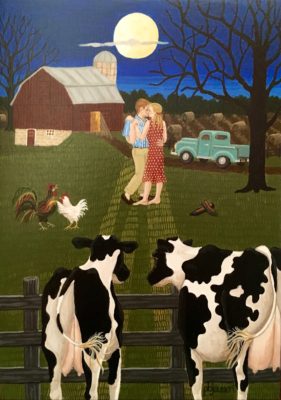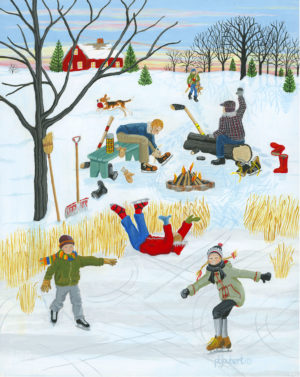Questions & Artists: Folk Artist Polly Joubert
- Share
- Tweet
- Pin
- Share

Sprawling farmsteads, Door County lighthouses and iconic Midwest landscapes are given a folk art narrative in the colorful, whimsical works of Wisconsin painter Polly Joubert.
The Nashotah, Wis. artist has been exhibiting her talents for acrylic storytelling at juried exhibits and galleries for the past five years, and since 2016 has been represented in Door County by Fine Line Designs Gallery in Ephraim.
Joubert’s paintings are sometimes imaginative, sometimes factual but always detailed and delightful renderings of Midwestern values: family, farms and hometown celebrations. By incorporating people and animals into her scenes, Joubert strives to create work that encourages the viewer to linger and discover “all the small scenes and activities that comprise the whole, much like the child’s game of ‘finding all the apples hidden in the picture.’”
Her work is currently on display in the Cedarburg Cultural Center’s current exhibit, The Little Show, showcasing paintings no larger than 36 square inches.
I recently caught up with Joubert to talk folk art, her artistic influences, and upper Midwestern values. To view more of Joubert’s folk art, visit pollyjoubertart.com.
Alyssa Skiba (AS): You describe yourself as a regional, narrative painter. What influenced your decision to tell stories through painting?
Polly Joubert (PJ): It was never a conscious decision to be a regional, narrative painter. I grew up in Wisconsin and have lived most of my life here. I think it is the most beautiful place in all of God’s creation. Early on I painted scenes with which I was familiar and in which I was often an active participant. I painted things that I knew from experience and memory or had heard stories about. Inserting people and animals into a painting automatically creates activity, which tells a story or multiple stories. I think the addition of people and animals allows me to express my values, the joy of life and, occasionally, some humor.
AS: What kind of stories are you compelled to tell?
PJ: I think the storytelling harkens back to the teacher in me and to my love of history, be it history in the public realm or things personally remembered and celebrated. I painted a series of six images featuring four of the lighthouses of Door County, their keepers, keepers’ families and the daily activities or prominent events that commemorate the history of each place. I have painted images of family reunions, holidays celebrated, work being done and fun being had. I guess all of my paintings reflect and celebrate what I think of as the beauty and the values of the upper Midwest.
AS: Describe folk art and your role in it.
PJ: As I understand it, folk art is that slice of the art world that is done by the untrained, natural artist. Although I was an elementary school art teacher, my educational background only included Drawing 101 and Painting 101. There is so much about art techniques and materials that I don’t know and at this point in life I don’t have a lot of time or wherewithal to explore them. That seems like I am not intellectually curious. I am! But I just want to get whatever is going on in my head down on a gessoed board. My paintings take a long time to complete because I get so involved in the details (again, more research opportunities!). I don’t want to experiment, I just want to paint. I think that’s what makes me a folk artist.
AS: Folk artist Grandma Moses’ influence on your work is evident. Do you remember the first painting of hers that you saw?
PJ: When I was a little kid, my mom bought a couple of china plates that were each decorated with a different image done by Grandma Moses. One was “Catching the Thanksgiving Turkey.” The other was “Out for the Christmas Trees.” Even then, the simplicity and the stories delighted my imagination. I believed I could do that, too.
AS: Your inspiration for a piece is equally rooted in reality and imagination. What other elements come into play?
PJ: When I am painting a historical building or scene, I make use of every aspect of research I can possibly find: diaries, histories, news articles, census records, archival photographs, and interviews. The details here are so important. When I work with memories and personal histories, I do use my imagination to fill in the gaps or even create a story, but I also research the daily objects, the clothing, the breeds of animals, the vehicles (even the license plates!) to make sure every detail is as correct as possible for the time I am recreating. Even when my story is rooted in current times but contains elements with which I’m not as familiar (tent camping, for instance), I still do research so the details will be right.
AS: What do you hope to accomplish with your artwork?
PJ: I want to share joy and contentment through images that explore life in the upper Midwest, centered around family, hard work and simple fun. I want to encourage the attitudes and values defined by that life. Several times I’ve heard my paintings described as “happy.” If that’s the case, I think I’ve accomplished my goal.





